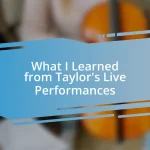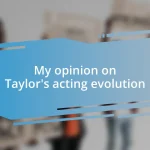Key takeaways:
- Taylor’s films exemplify the power of collaboration, bringing together diverse perspectives to create rich, engaging narratives.
- Key collaborators, such as cinematographers and music composers, enhance the storytelling process, fostering innovation and emotional depth.
- The audience’s connection to collaborative films stems from authenticity and shared creativity, inviting deeper engagement and discussions around the narratives presented.

Introduction to Taylor’s Films
Taylor’s films offer a refreshing look into the art of collaboration, blending various perspectives to create truly engaging stories. I remember the first time I watched one of her collaborative pieces—it felt like having a conversation with close friends who each brought their own unique tales to the table. Have you ever noticed how different voices can add depth to a narrative? That’s exactly what Taylor does; her films are a testament to the power of teamwork in storytelling.
In each project, Taylor manages to showcase not only her vision but also the artistic contributions of her collaborators. This approach resonates with me on a personal level, as I’ve experienced firsthand how collaboration can lead to unexpected and delightful outcomes. Have you ever worked on a group project where different ideas sparked something greater than any one person could have created alone? Taylor captures that magic beautifully in her films.
Watching her collaborative films evokes a sense of community and shared purpose, drawing viewers into a world where every character matters. It’s a brilliant reminder of how storytelling can unite various voices, emotions, and experiences. I often find myself reflecting on the connections and emotions stirred by these films—what kind of conversations do they ignite for you?

Importance of Collaboration in Film
Collaboration in film is crucial, as it brings together diverse talents that enhance the storytelling process. I recall working on a short film project where each crew member contributed a distinct skill—one was a wizard at cinematography, while another had a knack for sound design. This synergy not only elevated our final product but also created an environment rich with innovation and creativity. Have you ever thought about how a simple idea can blossom into something extraordinary when more minds tackle it together?
The essence of filmmaking lies in the blend of various perspectives, and Taylor’s films exemplify this beautifully. I remember a particular scene in one of her collaborative projects that resonated deeply with me; it was the result of countless discussions among the team that led to a powerful moment on screen. It made me realize how collaboration can not only shape content but also stir emotions in ways that singular visions cannot. Isn’t it fascinating how teamwork can capture the complexity of human experiences?
Through joint efforts, filmmakers can paint a broader picture, drawing out intricate themes and nuanced characters. Watching Taylor’s films, I often feel as if I’m part of a larger tapestry of creativity where every thread adds to the depth of the narrative. It reminds me of the importance of listening to others and valuing their contributions—don’t you feel that when everyone has a voice, the story becomes more alive?
| Aspect | Collaboration in Film |
|---|---|
| Diversity of Ideas | Brings rich, varied perspectives to storytelling. |
| Innovation | Encourages creative solutions and unique approaches. |
| Emotional Depth | Enhances narratives through collective input, capturing complex feelings. |

Key Collaborators in Taylor’s Career
Taylor’s journey in filmmaking is marked by a series of key collaborators who have significantly shaped her artistic vision. Each partnership brings fresh ideas and diverse backgrounds, enriching the storytelling fabric of her films. I recall attending a screening where the director spoke passionately about their collaborative process, sharing how open dialogues with cinematographers and actors often led to spontaneous, unforgettable moments on screen. It’s that kind of collaboration that transforms a good scene into something truly memorable.
Some of Taylor’s notable collaborators include:
- Cinematographer: Their eye for detail transforms ordinary scenes into stunning visual narratives.
- Screenwriter: This partner breathes life into characters, crafting dialogues that resonate with authenticity.
- Music Composer: Their scores amplify emotions, heightening the impact of pivotal scenes.
- Production Designer: This collaborator creates immersive worlds that draw viewers deeper into the story.
I feel inspired when I think about how these individuals inject their creativity into the filmmaking process, making it a shared journey rather than a solitary endeavor. It’s like a potluck dinner where everyone contributes a unique dish, making the overall meal richer and more satisfying. Each collaborator adds a layer—much like those ingredients meld together to create a perfect harmony on the plate.

Analysis of Collaborative Techniques
The collaborative techniques in Taylor’s films often showcase the interplay between visual storytelling and character development. I remember watching behind-the-scenes footage of one of her projects, where the actor and director engaged in an impromptu discussion about a character’s emotional arc. It struck me how this kind of back-and-forth not only sparks creativity but also fosters authenticity in the portrayal of complex emotions. Isn’t it amazing how dialogue among collaborators can reshape a performance into something profoundly relatable?
Furthermore, Taylor skillfully employs workshops and brainstorming sessions, inviting input from her entire team. This inclusive approach reminds me of a writing retreat I attended; the atmosphere was charged with excitement as ideas flowed freely. Each voice was valued, leading to unexpected plot twists that enriched the narrative. Don’t you agree that when everyone feels empowered to contribute, the possibilities seem endless?
I also find her use of feedback loops particularly intriguing. In my own experiences, I’ve seen how presenting rough cuts for team discussions can unveil hidden gems or areas for improvement. Taylor’s willingness to embrace constructive criticism enhances her films, creating a sense of community and shared ownership over the final product. Have you ever experienced that thrill when a team collaboratively fine-tunes something into a masterpiece?

Impact of Collaboration on Storytelling
Collaboration profoundly impacts storytelling by introducing diverse perspectives that can reshape narratives. I vividly remember when discussing a concept with a fellow writer, and as we tossed around ideas, my initial vision morphed into something more intricate and layered. It’s fascinating how the melding of different viewpoints enhances the depth of characters and plots, leading stories into unexpected directions that resonate more deeply with audiences. Have you ever had a conversation that completely altered your perspective on a familiar topic?
Moreover, Taylor’s collaborative process emphasizes the organic nature of storytelling. During a workshop I attended, one actor improvised a line that wasn’t in the script, which led to an emotional breakthrough for their character. This spontaneity often leads to a more natural, relatable performance that engages viewers on a personal level. I believe it’s this kind of flexibility within collaboration that keeps the storytelling fresh and dynamic—a reminder that great stories often emerge from a dance of ideas rather than a rigid plan.
Also, I can’t help but think about how collaboration fosters a sense of community. I once took part in a film project where everyone, from the editor to the costume designer, shared their thoughts in a roundtable discussion. It was incredibly empowering to witness how varied backgrounds and expertise can create a rich tapestry of storytelling. In Taylor’s films, this communal energy is palpable, giving life to narratives that feel both authentic and profoundly connected to the audience’s experiences. Isn’t it remarkable how collaboration not only enriches a story but also builds lasting bonds among creators?

Audience Reception of Collaborative Works
Audience reception of collaborative works reveals how these films resonate with viewers on a deeper level. I recall attending a screening of one of Taylor’s collaborative films, where audience members reacted not only to the story but also to the vibrant energy created by the ensemble cast. The shared experience of collective creativity seemed to mirror their own personal connections to the characters, forging an emotional bond that left a lasting impression. Isn’t it fascinating how collaboration can ripple out, touching the audience in ways we might not expect?
When watching Taylor’s projects, I often sense that audiences appreciate the authenticity born from collaboration. For instance, I remember a particular scene that sparked a lively discussion among friends after the film. The way the characters interacted felt genuine, almost like eavesdropping on real conversations. This is where that behind-the-scenes camaraderie translates into something tangible for viewers. Don’t you think such authentic portrayals have the power to transform a regular viewing experience into something extraordinary?
It seems that the excitement around collaborative films like Taylor’s often encourages audiences to engage more critically with the content. I recently joined a film discussion group, and we spent hours unpacking the nuances of Taylor’s latest project. The varying interpretations fueled an invigorating debate, highlighting how each person brought their unique perspective to the table—a direct reflection of the collaborative process at its core. How thrilling it is to realize that collaborative efforts create films that invite this kind of thoughtful discourse among audiences!

Conclusion and Future Collaborations
Looking ahead, I envision a rich tapestry of future collaborations that continue to challenge and inspire creators in profound ways. The chemistry that Taylor nurtures among storytellers is a foundation for innovation; think about how each new project could blend established talents with emerging voices. As I reflect on a recent workshop where a mix of seasoned filmmakers and beginners exchanged ideas, I couldn’t help but feel an electric sense of possibility. How might this eclectic combination reshape the narratives we see on screen?
Every time I watch a collaborative film, I’m struck by the potential it holds for redefining genres. For instance, I once participated in a script read where genres seamlessly intertwined, resulting in fresh, genre-bending storytelling. I believe that Taylor’s future collaborations could push these boundaries even further, inviting creators to explore daring concepts. Isn’t it exciting to think about where the next wave of collaborative storytelling could take us?
As we think about the impact of these partnerships, I believe they could play a crucial role in addressing contemporary issues. During a group brainstorming session I attended, we explored how different cultural narratives could converge to shed light on social themes. It’s clear that collaboration can empower filmmakers to tackle complex subjects that resonate with today’s audiences. With Taylor at the helm, I genuinely believe the future of collaborative films has the potential to spark important conversations and inspire change. Wouldn’t it be incredible to see stories that not only entertain but also enlighten?














